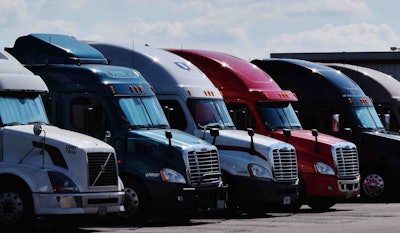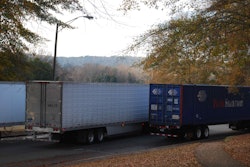 Much of the software available for owner-operator business bookkeeping is accessible via the web, making mobile devices powerful expense tracking tools during downtime on the road.
Much of the software available for owner-operator business bookkeeping is accessible via the web, making mobile devices powerful expense tracking tools during downtime on the road.Bookkeeping is one of the most important activities of successful owner-operators. The receipts and records you keep are used in a number of areas of your business – income tax reporting and minimization, warranty issues, maintenance information and monthly profitability, to name a few.
A business services provider can save you time with this task, but you should take an active role in collecting the information. The more organized and thorough you can be in your receipt gathering, the better.
You can simplify the bookkeeping task by following six simple practices that translate to higher profit with less hassle:
1. SAVE EVERY RECEIPT, NO MATTER HOW SMALL. Why “tip” the taxman? It’s the job of your business services provider to help you deduct as many legitimate costs as possible. Place an envelope in your truck for collecting your receipts and at the end of each month, send them to your business services provider, who can sort and tally them and provide you with a monthly profit and loss statement as well as accurate quarterly tax estimates. Whether you’re building spreadsheets on a laptop or using online software such as that available at mygauges.com or other vendors, the receipts are crucial in case you are audited. Scanned images of receipts are acceptable; keep the original paper copy for any big-ticket item for warranty purposes. ATBS will scan the contractor’s receipts and provide a CD with the data to the owner-operator at the end of the year. ATBS also allows owner-operators to view scanned receipts and financial documents online; this helps owner-operators track and manage paperwork easily when they are on the road and pull up key information, such as the receipt for the purchase of a battery that proves it is under warranty.

For easy reference, a list of deductible items is shown in Appendix 4. If you’re not sure if something is tax-deductible, save the receipt and check with your business services provider.
2. OPEN A SEPARATE CHECKING ACCOUNT FOR YOUR BUSINESS. If you are the sole owner of the business, open an additional personal account and save yourself the extra fees that are associated with business accounts. Deposit your settlement checks and collected invoices in this account, and pay yourself for driving from these funds. The amount to pay yourself is determined by your budget.
Pay all business expenses from this account. A separate account also will give you easy access to needed information in case you are audited, and bank fees for this account are tax-deductible.
3. USE A SEPARATE CREDIT CARD FOR BUSINESS EXPENSES. Find a credit card without an annual fee and with a low interest rate and, ideally, a generous rewards plan. Pay the balance in full every month.
4. SAVE YOUR LOG BOOKS. Your log book and/or electronic log records are your best proof of your entitlement to per diem (daily) expenses, mainly meal costs. If you’re using electronic logs, know how to save and access your history.
5. GET A NOTEBOOK TO CARRY WITH YOUR RECEIPT ENVELOPE. Use this notebook – alternately, a document or spreadsheet record on your smartphone or computer – to record those expenses for which you cannot obtain a receipt, such as when you wash your truck at a coin-operated facility, personal use of your auto, etc. Give a monthly record of these expenses to your business services provider along with your other receipts. You must track the date, location, amount and reason for each expense to meet Internal Revenue Service regulations. Special circumstances include:
Entertainment. Expenses for entertaining yourself, such as movie rentals or books, are not deductible. However, if you entertain a business associate, such as a fleet manager or shipping clerk, the expense is deductible. Note the cost of the expense, the date, names of who was there and the meeting’s purpose.
Business gifts. If you make a gift to a business associate such as a dispatcher or a customer, record the cost, date, gift description, the recipient’s name and relationship to you.
Transportation. For use of a personal vehicle for business, include the cost of the car and improvements, the date you started using it for business, mileage for each business use and annual total miles. Include your business destination and purpose of each trip.
6. SAVE YOUR RECORDS. You must keep the records that were used to prepare your tax return – records that support income and deductions – for at least three years from the date you filed the return.
Other records to keep for your business include IRS quarterly estimated tax payments; monthly profit-and-loss statements; insurance documentation; maintenance records and reports; warranty information, which should be available immediately to keep your truck on the road and minimize downtime and maintenance costs; required registration information; settlement statements from your carrier if you’re leased; and bank statements, business credit card statements and canceled checks.
Simplifying recordkeeping
Creating basic monthly income/expense reports, profit and loss statements and tax reports is accomplished more easily with simplified recordkeeping. Business services help greatly here, but for those not utilizing a service, a simple process for gathering and organizing your paper receipts, combined with an online software tool or custom spreadsheets on your computer, can allow you to input your own data and do the computations with the least amount of effort to create the reports:
•Pick up an expanding folder at an office supply store – likewise blank labels for the folders, a stapler and a desktop calculator with a register tape. Fill out the pocket labels with the categories listed in the box here. Some will not apply if you don’t employ another driver or have space devoted to an office or shop.
•Every category must be business-related. Car expenses apply only to business-related trips, such as to your truck dealer or repair shop.
•When you get a receipt, drop it in the corresponding pocket – fuel, settlements or any expenses document.
•At the end of each month, schedule two hours for accounting. You soon will find you can get this done in less time.
•Add the receipts in the folder’s first pocket. Staple the register tape to the corresponding pile of receipts, and drop them back in the same slot. Since they are stapled, they won’t get mixed with new receipts. Do the same for the remaining categories.
•Supplement this system by noting your odometer reading on the first of every month. This allows you to track total monthly miles and then calculate your true income per mile and costs per mile.
•Using online software, such as the mygauges.com software created by trucking radio host Kevin Rutherford, or other programs, create a monthly entry for each category and enter your settlement data. Use the software or spreadsheet data to create your reports and manage your business.
Expense categories if business-related
•Car expense
•Fees and commissions
•Fuel, oil and additives
•Insurance
•Interest paid
•Legal and accounting
•Loading and unloading
•Meals and entertainment
•Nonoffice supplies
•Office supplies
•Physicals and drug testing
•Rent or lease
•Repairs and maintenance
•Scale fees
•Settlements
•Taxes and license
•Tolls and parking
•Travel
•Utilities
•Wages and payroll
•Uniforms and laundry












